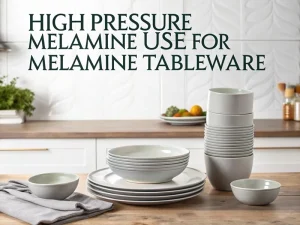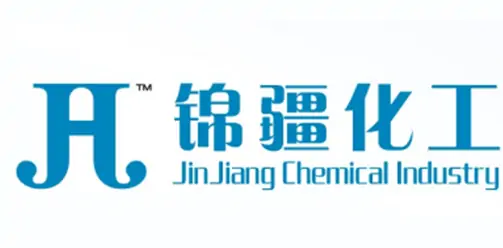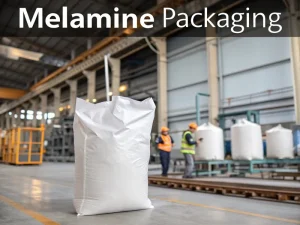
High Pressure Nelamine Use For Melamine Tableware Advantage
Tech Blog High Pressure melamine Use For Melamine Tableware Melamine tableware has become a staple for households, restaurants, and catering services worldwide due to its

In the fiercely competitive melamine tableware market, what can make your product – whether it’s plates, bowls, or cups – stand out from many competitors? The answer often lies in a perfect, mirror-like final finish. This excellent texture and durability do not come from the base molding material, but from a crucial final step: the application of melamine Glazing Powder.
Melamine glazing powder is crucial for achieving smooth, durable, and aesthetically pleasing surface treatment on melamine tableware and cutlery. It is the final critical component used in the molding process, converting simple melamine blocks into high-quality finished products that can be used for commercial and household purposes.
However, to master its application and unleash its maximum potential, precise knowledge and skills are required.
Firstly, a key distinction must be clarified:
You can imagine it as the “varnish” of wooden furniture: the molding material is the wood itself, and the topcoat is the transparent coating that gives luster and protection.
The application of polishing powder is not optional, but a standard process for producing high-quality melamine products. The core advantages it brings include:
Although its principle is simple, the application of melamine-coated powder is mainly concentrated in fields that require high surface quality:
High-end melamine tableware is its most widely used application, encompassing plates, bowls, cups, trays, and spoons, particularly those sold to quality-conscious hotels, restaurants, and retail markets.
Children’s tableware with patterns: To protect the cute cartoon patterns from wear and ensure absolute safety, polishing is an essential process.
Bathroom products and ashtrays: For melamine products that require bright and easy-to-clean surfaces, such as soap boxes, toothbrush holders, etc.
Electrical enclosures and handles: They are also used on specific industrial components that require surface smoothness and wear resistance.
The correct application process is the key to achieving perfect results. The following are the polishing steps in the standard two-step molding method:
Prerequisite: The main shape of the tableware has been preliminarily hot-pressed and molded from A5 melamine molding material in the mold.
After the mold is opened, the initially formed tableware is still very hot. At this point, it is necessary to quickly clean its surface with an air gun or a clean cloth to remove any possible dust or impurities. If the product requires decals, this is the step of applying the decal paper.
Using a specialized tool with a fine mesh (similar to a pepper can), evenly and thinly sprinkle melamine powder onto the surface of hot tableware.
Key point: Uniformity is the king! Spraying too much powder can lead to cost waste and possible flow marks; Insufficient powder application prevents the formation of a complete glossy layer, resulting in dark spots or pockmarks. Experienced operators are the guarantee of the quality of this step.
Close the mold and apply high temperature and pressure again. Typically, the temperature during the polishing process is slightly higher and the time is shorter than that of the initial molding. During this process, the polishing powder melts, flattens, and firmly binds with the tableware substrate, ultimately solidifying into a transparent glassy film.
Open the mold and take out the final product. At this moment, the product has a shiny luster. Afterwards, polish the edges, inspect, and package.
There are different models of gloss powder on the market, with the main difference being their flowability and final glossiness:
LG220: The most commonly used standard model, providing excellent glossiness and good operability, with high cost-effectiveness.
LG110: It offers improved fluidity and is particularly well-suited for products with complex shapes or those that require covering large areas of sticker paper, ensuring that the powder flows smoothly to every corner.
LG250: a top-level model designed for the highest-end products that pursue ultimate glossiness, bringing the brightest and closest ceramic texture effect.
The application of melamine glaze powder is the final step in manufacturing high-quality melamine tableware, not a simple additional step. It is the core process that defines product quality, value, and lifespan. Creating a hard, transparent, and pore-free surface layer offers several fundamental benefits: excellent scratch and stain resistance, enhanced hygiene, and a beautiful, glossy finish. For manufacturers seeking to produce durable, attractive, and food-safe melamine products, selecting and applying melamine glaze powder correctly is crucial.
If you would like to learn more about Shangguang Powder, please get in touch with us!

Tech Blog High Pressure melamine Use For Melamine Tableware Melamine tableware has become a staple for households, restaurants, and catering services worldwide due to its

Tech Blog Melamine packaging For manufacturers, inaccurate packaging not only fails to meet national standards but also increases labor costs and the risk of product

Tech Blog How to Detect Melamine in Textiles? Melamine powder, a nitrogen-containing heterocyclic compound, is widely used in flame-retardant textiles and plastic products due to

JINGJIANG MELAMINE POWDER
© JINJIANG MELAMINE